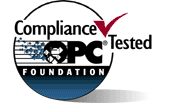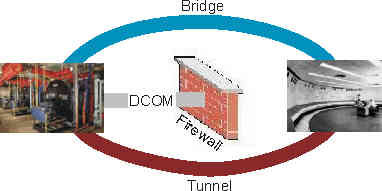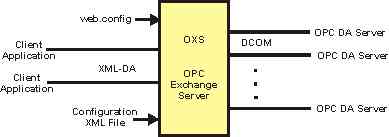DCOM Bridge
|
The DCOM Bridge connects remote OPC DA server/clients with minimal DCOM configuration issues and allows the step-wise migration from OPC DA to XML DA web services.
Used on .NET3 (WCF) the communication can be configured for different protocols to match the particular application requirements, e.g. standard web service, high performance TCP/IP or encrypted HTTP.
The DCOM based OPC DA cannot be used accross domains and through firewalls. Other techniques need to be used to get data from the large number of installed OPC DA servers to clients at remote locations and from the shop floor to the enterprise level.
Even in local area network configuration with possible DCOM communication the DCOM configuration can be a headache. The DCOM Bridge greatly simplifies the setup. The COM configuration cannot be completely eliminated as long as OPC DA servers/clients are used because OPC DA server are specified as COM servers. However, with the Bridge module on the same computer as the OPC DA server/client only the much less problematic local COM server access needs to be configured. |
 |
 |
|
Bridge
A bridge solution uses a higher level standardized communication protocol suitable for inter-domain communication. Web services and XML DA fulfill the requirements and are supported in all environments. A bridge using these standards not only connects existing OPC server/clients but also eases the migration to web services.
Either side bridge component can independently be replaced with an XML DA application as such become available.
- An OPC DA server and Bride module can be replaced by an XML DA server without any changes on the client side.
- An OPC DA client and Bridge component can be replaced by an XML DA client without any changes on the server side.
Different vendors offer OPC client components that support OPC DA and XML DA server access from the same client code. With the client working in XML DA mode no Bridge module is required on the client side.
|
| |
Tunnel
A tunnel solution uses lower level protocols such TCP/IP for a propritary communication protocol suitable to transport OPC data through firewalls. Always a pair of communication drivers from the same vendor have to be used. |
The Advosol OPC Bridge uses the OPC XML-DA standard and consists of a pair of gateways:
| Client-side Gateway |
The client-side gateway enables OPC DA clients to access XML DA servers. The server may be the OPC Bridge server-side gateway but it can also be an XML DA compliant server or gateway from any vendor.
The client-side gateway is an OPC DA V2.05 and V3.0 compliant OPC server that acts as an XML DA client.

New client applications can be created as XML DA clients and access the server-side gateway without need for a client-side gateway. Different vendors offer client development components that support OPC DA and XML DA server access from the same code. The Advosol XMLDA.NET is such a component. Such client applications can access OPC DA server directly or through a server-side Gateway.
|
| Server-side Gateway |
The server-side gateway enables OPC DA servers to be accessed from XML DA clients. Such a client can be the OPC Bridge client-side gateway or any XML DA client such as an XML DA driver in a SCADA package or a custom Visual Basic application.
The server-side gateway is an XML DA 1.01 compliant web service that acts as an OPC DA client.

|
Client-side Gateway
The Advosol XDAGW-CS client-side gateway is an OPC DA V2/V3 compliant server that converts client requests to XML-DA. It can access any XML DA V1.01 compliant server and offers high performance and is simple to use. Basically only the URL of the XML-DA server needs to be configured.
Server-side Gateway
Advosol offers two products that can be used as server-side gateways:
| The XDAGW-SS Server Side Gateway |
has a simple static configuration and handles only one OPC DA server. Multiple instances can be installed to handle multiple OPC DA servers.
The gateway is XML DA V1.01 compliant and can access OPC DA V2 and V3 servers. If the OPC DA server is V3 compliant then the WriteVQT is used to support writing of values with quality and timestamp.
The interactive configuration utility guides through the configurtion and tests the setup.

|
| The OXS OPC Exchange Server |
can access multiple OPC DA servers. The static configuration is quick and simple using the supplied configuration utility.
The OPC Exchange server can be configured for direct server-server data exchange.

|
|
|
|
System Requirements |
 |
Windows XP or Windows 2000 and .NET Famework |
 |
IIS with .NET1.1 or .NET2 |
 |
.NET3 (WCF) for secure communication |
Order Info
Please order the Bridge as a pair of gateways. One client-side gateway and one server-side gateway or OPC Exchange Server.
| 